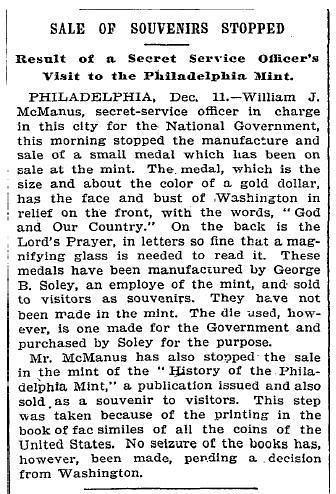
PREV ARTICLE
NEXT ARTICLE
FULL ISSUE
PREV FULL ISSUE
V11 2008 INDEX
E-SYLUM ARCHIVE
RESEARCH ON GEORGE SOLEY UNCOVERS SECRET SERVICE BANNING OF U.S. MINT BOOK
Dick Johnson submitted this doubly interesting report
discussing the Secret Service's banning of G.G. Evans' book on the U.S.
Mint, and George Soley's purchase of the Mint's first stem press. -Editor
 I was adding to my entry on George B. Soley in
my artists databank this week and discovered the U.S. Secret Service once
stopped the sale of "History of the Philadelphia Mint" to quote the news
article I found in the New York Times for December 12, 1894.
I was adding to my entry on George B. Soley in
my artists databank this week and discovered the U.S. Secret Service once
stopped the sale of "History of the Philadelphia Mint" to quote the news
article I found in the New York Times for December 12, 1894. The book was obviously George Evans' Illustrated History of the United States Mint (the NYT got the title wrong!).
The news article stated that the Secret Service officer in charge of the Philadelphia office, William J. MacMannus, stopped the U.S. Mint from selling copies of the book. Reason? It contained "fac similies [read illustrations] of all the coins of the United States."
He didn't confiscate any books. "No seizure of the books, has, however, been made, pending a decision from Washington," continued the news article, which was the second paragraph under the headline "Sale of Souvenirs Stopped."
The main thrust of the news article -- and this was my research interest -- was the item in the first paragraph. While still on the staff of the Philadelphia Mint Engraving Department, George B. Soley had purchased the first steam press -- as surplus! -- from the Mint in 1875. (This press was later donated to the Franklin Institute in 1927 by Soley's widow, and even later, in 2000, to the American Numismatic Association, and is now ensconced in a plastic box outside ANA Headquarters in Colorado Springs.)
Soley refurbished the press so it was able to run manually and he carted it to Philadelphia parades and fairs. For the American Centennial Exposition in 1876 he struck medals in two sizes: silver-dollar size medals from eight dies with frequent muleing (these were HK 48 to HK 72c) and gold-dollar size mostly with the Lord's Prayer and the Liberty Bell.
For the latter he had purchased obsolete tooling from the Mint, like 12.7mm collars and blanking dies formerly used for the U.S. gold dollar of 1849-54. He did all his striking on his own time in his own residence, from dies we assumed he engraved himself. Philadelphia Mint officials were aware of what he was doing and perhaps encouraged him. The Mint itself was selling Soley's homemade medals.
But it was these little medalets with an obverse portrait of Washington and the Lord's Prayer on the reverse (Baker 651) that Secret Service agent MacMannus halted the sale of, along with Evans' book, at the Mint in December 1894. (Rulau tells us Soley sold these medalets for 25 cents at the Chicago Columbian Exposition in 1893.)
Contrast that with the present day's gift shop in the Philadelphia Mint. I am certain agent MacMannus wouldn't have stepped foot inside the Mint's door. Let's hope MacMannus was censured from Washington for overstepping his authority two weeks before Christmas in 1894.
For more information on the Mint's steam press, see: Steam-Powered Coin Press (http://www.fi.edu/learn/sci-tech/coin-press/
coin-press.php?cts=instrumentation)
Wayne Homren, Editor
The Numismatic Bibliomania Society is a non-profit organization promoting numismatic literature. See our web site at coinbooks.org.
To submit items for publication in The E-Sylum, write to the Editor at this address: whomren@gmail.com
To subscribe go to: https://my.binhost.com/lists/listinfo/esylum
All Rights Reserved.
NBS Home Page
Contact the NBS webmaster
